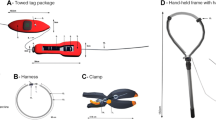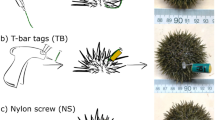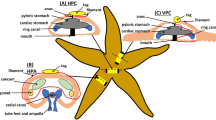Abstract
This study details a simple and cost-effective means of attaching acoustic transmitters to coral reef sharks and stingrays, which potentially allows for retrieval and reuse on completion of tracks. Between 2008 and 2011, galvanised timed releases were trialled in both static field tests and on blacktip reef sharks Carcharhinus melanopterus, cowtail Pastinachus atrus, and porcupine Urogymnus asperrimus rays in Coral Bay (−23°08′41″, 113°45′53″), Western Australia. The timed releases remained attached to animals for the duration required for tracking and in four out of five deployments transmitters were recovered after release from the animals. The use of modified Rototags for sharks and stainless steel darts for stingrays allowed rapid and effective attachment to animals, with limited impact on their welfare in the short term. External attachment for short-term tracking of coral reef-associated elasmobranchs should be considered as a complementary option to internal placement of transmitters in animals either by surgery or by ingestion.






Similar content being viewed by others
References
Bansemer CS, Bennett MB (2009) Reproductive periodicity, localised movements and behavioural segregation of pregnant Carcharias taurus at Wolf Rock, southeast Queensland, Australia. Mar Ecol Prog Ser 374:215–227
Bass GA, Rascovich M (1965) A device for the sonic tracking of large fishes. Zoologica 50:75–82
Blaylock RA (1990) Effects of external biotelemetry transmitters on behavior of the cownose ray Rhinoptera bonasus (Mitchill 1815). J Exp Mar Biol Ecol 141:213–220
Bres M (1993) The behaviour of sharks. Rev Fish Biol Fish 3:133–159
Bruce BD, Stevens JD, Bradford RW (2005) Designing protected areas for grey nurse sharks off eastern Australia—Report to the Australian Government Department of the Environment and Heritage. CSIRO Marine and Atmospheric Research, Hobart
Bruce BD, Stevens JD, Malcom H (2006) Movements and swimming behaviour of white sharks (Carcharodon carcharias) in Australian waters. Mar Biol 150:161–172
Brunnschweiler JM (2009) Tracking free-ranging sharks with hand-fed intra-gastric acoustic transmitters. Mar Freshw Behav Physiol 42:201–209
Carey FG, Scharold JV (1990) Movements of blue sharks (Prionace glauca) in depth and course. Mar Biol 106:329–342
Cartamil D, Vaudo J, Lowe C, Wetherbee B, Holland K (2003) Diel movement patterns of the Hawaiian stingray, Dasyatis lata: implications for ecological interactions between sympatric elasmobranch species. Mar Biol 142:841–847
Chapman DD, Pikitch EK, Babcock E, Shivji MS (2005) Marine reserve design and evaluation using automated acoustic telemetry: a case study involving coral reef-associated sharks in the Mesoamerican Caribbean. Mar Technol Soc J 39:42–55
Collins A, Heupel M, Motta P (2007) Residence and movement patterns of cownose rays Rhinoptera bonasus within a south west Florida estuary. J Fish Biol 71:1159–1178
Dewar H, Mous P, Domeier M, Muljadi A, Pet J, Whitty J (2008) Movements and site fidelity of the giant manta ray, Manta birostris, in the Komodo Marine Park, Indonesia. Mar Biol 155:121–133
Economakis AE, Lobel PS (1998) Aggregation behavior of the grey reef shark, Carcharhinus amblyrhynchos, at Johnston Atoll, Central Pacific Ocean. Environ Biol Fishes 51:129–139
Franklin CE, Read MA, Kraft PG, Liebsch N, Irwin SR, Campbell HA (2009) Remote monitoring of crocodilians: implantation, attachment and release methods for transmitters and data-loggers. Mar Freshw Res 60:284–292
Gleiss AC, Norman B, Leibsch N, Francis C, Wilson RP (2009) A new prospect for tagging large free-swimming sharks with motion-sensitive data-loggers. Fish Res 97:11–16
Hazel J (2009) Evaluation of fast-acquisition GPS in stationary tests and fine-scale tracking of green turtles. J Exp Mar Biol Ecol 374:58–68
Heupel MR, Simpfendorfer CA (2005) Quantitative analysis of aggregation behavior in juvenile blacktip sharks. Mar Biol 147:1239–1249
Heupel M, Simpfendorfer C, Bennett M (1998) Analysis of tissue responses to fin tagging in Australian carcharhinids. J Fish Biol 52:610–620
Holland K, Lowe C, Peterson J, Gill A (1992) Tracking coastal sharks with small boats: hammerhead shark pups as a case study. Mar Freshw Res 43:61–66
Houghton JDR, Liebsch N, Doyle TK, Gleiss A, Lilley MKS, Wilson RP, Hays GC (2009) Harnessing the Sun: testing a novel attachment method to record fine scale movements in Ocean Sunfish (Mola mola). Review. Methods Technol Fish Biol Fish 9:229–242
Jewell OJD, Wcisel MA, Gennari E, Towner AV, Bester MN, Johnson RL, Singh S (2011) Effects of smart position only (SPOT) tag deployment on white sharks Carcharodon carcharias in South Africa. PLoS One 6:e27242
Johnson R, Bester MN, Dudley SFJ, Oosthuizen WH, Meyer M, Hancke L, Gennari E (2009) Coastal swimming patterns of white sharks (Carcharodon carcharias) at Mossel Bay, South Africa. Environ Biol Fishes 85:189–200
Kohler NE, Turner PA (2001) Shark tagging: a review of conventional methods and studies. Environ Biol Fishes 60:191–223
Le Port A, Sippel T, Montgomery JC (2008) Observations of mesoscale movements in the short-tailed stingray, Dasyatis brevicaudata from New Zealand using a novel PSAT tag attachment method. J Exp Mar Biol Ecol 359:110–117
Lowe CG, Wetherbee BM, Meyer CG (2006) Using acoustic telemetry monitoring techniques to quantify movement patterns and site fidelity of sharks and giant trevally around French Frigate Shoals and Midway Atoll. Atoll Res Bull 543:281–303
McKibben JN, Nelson DR (1986) Patterns of movement and grouping of gray reef sharks, Carcharhinus amblyrhynchos, at Enewetak, Marshall Island. Bull Mar Sci 38:89–110
Nakano H, Matsunaga H, Okamoto H, Okazaki M (2003) Acoustic tracking of bigeye thresher shark Alopias superciliosus in the eastern Pacific Ocean. Mar Ecol Prog Ser 265:255–261
Nelson DR (1977) On the field study of shark behavior. Am Zool 17:501–507
Nelson DR (1990) Telemetry studies of sharks: a review, with applications in resource management. National Marine Fisheries Service, NOAA technical report 90
Nelson DR, Johnson RH (1980) Behavior of reef sharks of Rangiroa, French Polynesia. Natl Geogr Soc Res Rep 12:479–499
O’Shea OR, Kingsford MJ, Seymour J (2010) Tide-related periodicity of manta rays and sharks to cleaning stations on a coral reef. Mar Freshw Res 61:65–73
Papastamatiou YP, Lowe CG, Caselle JE, Friedlander AM (2009) Scale-dependent effects of habitat on movement and path structure of reef sharks at a predator-dominated atoll. Ecology 90:996–1008
Papastamatiou YP, Friedlander AM, Caselle JE, Lowe CG (2010) Long-term movement patterns and trophic ecology of blacktip reef sharks (Carcharhinus melanopterus) at Palmyra Atoll. J Exp Mar Biol Ecol 386:94–102
Pratt HL, Carrier JC (2001) A review of elasmobranch reproductive behavior with a case study on the nurse shark, Ginglymostoma cirratum. Environ Biol Fishes 60:157–188
Rechisky EL, Wetherbee BM (2003) Short-term movements of juvenile and neonate sandbar sharks, Carcharhinus plumbeus, on their nursery ground in Delaware Bay. Environ Biol Fishes 68:113–128
Sciarrotta TC, Nelson DR (1977) Diel behavior of the blue shark, Prionace glauca, near Santa Catalina Island, California. Fish Bull 75:519–528
Simpfendorfer CA, Heupel MR (2004) Assessing habitat use and movement. In: Carrier JC, Musick JA, Heithaus MR (eds) Biology of sharks and their relatives. CRC Press, London, pp 553–572
Skomal GB, Lobel PS, Marshall G (2008) The use of animal-borne imaging to assess post-release behavior as it relates to capture stress in grey reef sharks Carcharhinus amblyrhynchos. Mar Technol Soc J 41:40–44
Speed CW, Field IC, Meekan MG, Bradshaw CJA (2009) Report following use of AATAMS VR100 (August 2009). Sydney Institute of Marine Science, Syndey
Speed CW, Field IC, Meekan MG, Bradshaw CJA (2010) Complexities of coastal shark movements and their implications for management. Mar Ecol Prog Ser 408:275–305
Speed CW, Meekan MG, Field IC, McMahon CR, Stevens JD, McGregor F, Huveneers C, Berger Y, Bradshaw CJA (2011) Spatial and temporal movement patterns of a multi-species coastal reef shark aggregation. Mar Ecol Prog Ser 429:261–275
Standora EA, Nelson DR (1977) A telemetric study of the behavior of free-swimming pacific angle sharks, Squatina californica. Bull South Calif Acad Sci 76:193–201
Stevens JD, Last PR, White WT, McAuley RB, Meekan MG (2009) Diversity, abundance and habitat utilisation of sharks and rays: final report to West Australian Marine Science Institute. In: CSIRO (ed), Hobart
Sundström LF, Gruber SH, Clermont SM, Correia JPS, de Marignac JRC, Morrissey JF, Lowrance CR, Thomassen L, Oliveira MT (2001) Review of elasmobranch behavioral studies using ultrasonic telemetry with special reference to the lemon shark, Negaprion bravirostris, around Bamini Islands, Bahamas. Environ Biol Fishes 60:225–250
Wetherbee BM, Gruber SH, Rosa RS (2007) Movement patterns of juvenile lemon sharks Negaprion brevirostris within Atol das Rocas, Brazil: a nursery characterized by tidal extremes. Mar Ecol Prog Ser 343:283–293
Wilson SG, Polovina JJ, Stewart BS, Meekan MG (2006) Movement of whale sharks (Rhincodon typus) tagged at Ningaloo Reef, Western Australia. Mar Biol 148:1157–1166
Yeiser BG, Heupel MR, Simpfendorfer CA (2008) Occurrence, home range and movement patterns of juvenile bull (Carcharhinus leucas) and lemon (Negaprion brevirostris) sharks within a Florida estuary. Mar Freshw Res 59:489–501
Acknowledgments
Funded by the Australian Institute of Marine Science and Murdoch University. The VR100 and hydrophone were provided through the Australian Animal Tracking and Monitoring System (AATAMS), a facility of Integrated Marine Observing System. Field work was done in compliance with research permits supplied by the Department of Environment and Conservation and the Western Australian Department of Fisheries (SF7536 and SF007122; CE002881 and CE002624; and 1719-2010-39 and RS457/98-05). Animal ethics for stingray handling was approved by Murdoch University Animal Ethics Committee (R2275/09). We thank F. McGregor, J. Ruppert, D. Simpson, Y. Berger, G. Vianna, D. Ilich, T. Hill, M. van Keulen and M. Langdon for assistance with field work.
Author information
Authors and Affiliations
Corresponding author
Additional information
Communicated by J. D. R. Houghton.
Rights and permissions
About this article
Cite this article
Speed, C.W., O’Shea, O.R. & Meekan, M.G. Transmitter attachment and release methods for short-term shark and stingray tracking on coral reefs. Mar Biol 160, 1041–1050 (2013). https://doi.org/10.1007/s00227-012-2151-y
Received:
Accepted:
Published:
Issue Date:
DOI: https://doi.org/10.1007/s00227-012-2151-y




